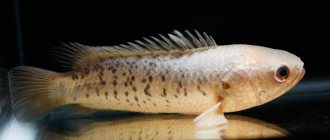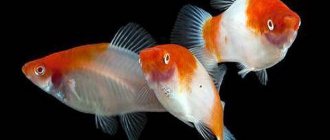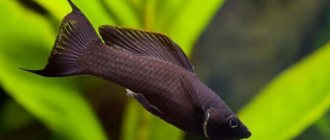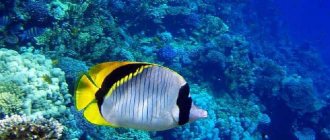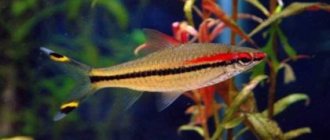The strap fish is an amazing sea creature. It is very long and has an unusual ribbon shape. For a long time, this fish was considered fantastic until it fell into the hands of researchers who confirmed that it actually exists, although it is rare due to its secretive lifestyle. Eyewitnesses who encountered her in the middle of the ocean or saw her remains on the shore consider this the most memorable sight in life.
Fish strap is shaped like a ribbon
Habitats
You can meet amazing fish in the warm or temperate waters of the Pacific, Atlantic, and Indian oceans. It is also found in Iceland and the North Sea. The animals are suited to hot tropical and dry Mediterranean climates, so they are not found in Russian waters, although some specimens were washed up on the shores of the Sea of Japan after a storm.
In water they feel good at a depth of 500 to 1000 m, but sometimes rise to the very surface. These fish are not able to resist the current, therefore they cannot actively swim in a horizontal direction, which allows them to be classified as oceanic ichthyoplankton. This species usually includes small organisms, so the king oar and the three-meter sunfish are exceptions .
The herring king was discovered in Russia
Residents of Primorye found a rare fish on the coast - the herring king. According to scientists, this is the first meeting with this species in Russia.
The belt fish had never been seen in Russia before, but in February the media wrote that several herring kings were found off the coast of the Japanese Toyama Prefecture. According to legend, the fish foretells earthquakes and tsunamis.
In Primorye, the herring king was found on August 5 in Pallada Bay, Antonina Tunyk, who managed to photograph the fish, told RIA Novosti.
“She had a terrible mustache, they thought she was poisonous. <…> When it swims, it seems like some kind of monster. The eyes are like those of an animal, they shine in the water like a mirror,” said the agency’s interlocutor.
According to her, the fish were eventually released into the sea.
Comments
Various titles
Biologist Peter Ascanius, who studied marine fauna, found two specimens on the coast of an ancient trading port in the Norwegian city of Bergen. In 1772, he made a scientific description of the species, which was given several names:
- common belt fish;
- belt;
- herring king.
In Latin the name sounds like Regalecus glesne. The first part of the species name is formed by combining the words “king” (rex) and “herring” (allec). The idea was borrowed from Norwegian fishermen, who gave the creature a name for its constant presence in schools of oceanic herring and the elongated first rays of the dorsal fin, forming a kind of crown on its head. The last word is an alteration of the name of the port of Glessver, where Ascanius found the fish.
Sometimes the fish is called by transcription from English - oarfish, but this creature also has more rare names. For example, in Japan he was given the poetic nickname “king of the underwater palace”, and some prosaically call him the “oar fish” for the characteristic rotation of his pelvic fins when moving.
The popular name for the belt fish is oar fish.
Why is it called that?
The second name of this amazing creature is the king fish. She received it because on her head there is a large bright crown formed from the long rays of the dorsal fin. This is its distinguishing feature from other fish of similar structure. The fish looks large and intimidating, but it is not dangerous to humans. The remnetel will not attack divers, because at the depths where this type of fish lives, they are quite rare.
Thanks to early photos, scientists were able to figure out that this species does not have sharp teeth, which means it only feeds on plankton and the like.
general description
The strap fish has a very unusual appearance. Its long body without scales, reaching 3.5 m, is only 5 cm thick and 25 cm high. It is colored silvery-white with dark short spots and stripes on the sides. The lateral line in the lower part of the body is long. There is no swim bladder.
The body is crowned by a short head of a bluish tint with large eyes and a small vertical mouth. On the body, covered with longitudinal rows of tubercles, there is a long dorsal fin consisting of several hundred soft rays. It originates above the eye and ends only on the back of the body. The 10–15 anterior rays are elongated compared to the subsequent ones and have membranous extensions at the apices.
The pectoral fins are short and located horizontally. Under them there are abdominal ones, consisting of only one long ray, at the end paddle-shaped flattened. The caudal fin has lost its main importance in the process of evolution and consists of several long free rays in young representatives. All organs of movement are bright red. Some ichthyologists argue that the primary role of fins is not movement, but the perception of taste. Currently, D. Olney is working to prove this statement by studying the past and present life of the harpfish.
The lifespan of the species has not yet been established.
Harfish, as a species, is listed in the Guinness Book of Records. He was awarded this honor for the largest size among all bony fish that currently exist. Some representatives grow almost 10 meters , the longest registered specimen reached 11 m, and the largest - 272 kg. https://youtube.com/watch?v=RCjmQMMJMcY
Brief description of Oarfish. Herring King
| Herring king | |||||||||||||
| Scientific classification | |||||||||||||
Kingdom:
| |||||||||||||
| Latin name | |||||||||||||
| Regalecus glesne Ascanius, 1772 |
The herring king, or belt-fish, or belt-fish (lat. Regalecus glesne) is a sea fish from the family of belt-bodied fish of the order Opaciformes. Pelagic (semi-deep-sea) fish found in warm and moderately warm waters of the Pacific, Atlantic and Indian oceans.
This fish can reach a length of up to 17 m and weigh up to 300 kg. Due to its size, the fish was listed in the Guinness Book of Records as the longest bony fish in the world. The most common specimens are from 2.5 to 5.5 m.
Lifestyle
The fish king moves very unusually compared to other inhabitants of the underwater world. Its body is located almost vertically in the water column, its head is at the top. The body of the harpfish has a higher specific gravity than water. To prevent it from sinking when swimming, the creature makes forward, wave-like movements with its long dorsal fin. This allows you to move at low speed. If a fish needs to move faster, it will bend not only its fin, but its entire body. Such data were obtained based on observations of a large specimen in Indonesian waters.
Oarfish is a predator. Its main food is represented by the following organisms:
- plankton;
- marine crustaceans;
- small fish;
- shellfish
Schools of herring, among which you can often find beltfish, can also become food for a predator.
Spawning of the creatures occurs from July to December. The female lays brightly colored eggs ranging in size from 2 to 4 mm. They drift with the ocean current and stay near the surface of the water. The sun does not affect them due to their bright colors that do not transmit ultraviolet rays. The larvae develop in the surface layer of water, mainly in winter.
Strap-fish or herring king (lat. Oarfish)
Having such a length, the width of her body can be only 5-7 cm. Straight to the envy of any model. Just because of these proportions, the fish is not called a belt-fish, a belt-fish, but the most famous name is the herring king.
The fish owes its unusual name - the herring king - to the elongated rays of the dorsal fin, which are equipped with membranous extensions at the tops. This whole structure on the head somewhat resembles a crown. And it was nicknamed the herring fish because it is found in schools of herring, which is its main diet.
The body of the herring king is covered with silvery-white bony scutes, and the head has a bluish tint.
But the most interesting thing is that these fish do not swim like everyone else - horizontally, but almost vertically, with their heads up.
Its habitat is the warm and moderately warm waters of the Pacific, Atlantic and Indian oceans. This fish is semi-deep-sea, so it can be found at depths from 50 to 700 meters, although there are numbers up to 1000 m.
Belgfish meat is inedible. Even animals refuse it!
Now scientists don’t know much about the herring king, because studying it requires the presence of the fish itself, and this is not so easy to do. The first scientific description of a “king” was made in 1771, when a “sea serpent” with a flowing fiery red mane was thrown ashore.
There are other cases of discovery of these fish - in February 1788 in Great Britain (length -2.5 m, weight - 20 kg), in March 1796, in the same place (length - 4 m), 1906, 1925 and 1986. Even now it can get caught in fishermen’s nets, but this happens extremely rarely.
Related species
Oarfish is a member of the family of ligaments, which also includes a very rare genus of agrosticths. Their description was compiled from only 7 specimens caught in the high seas of Australia, Tasmania, New Zealand and the south-eastern Atlantic Ocean.
The silvery body of agrostichts with a pink dorsal fin formed by 400 rays has no scales and is dotted with hard tubercles. The sensitive lateral line is represented by a continuous tube consisting of oblong plates. It is assumed that agrostiches do not grow more than 3 meters in length.
The order Oharfish is opaciformes. This means that its relatives include triggerfish and pearleyes, but the closest one is the serpentine fish. It is inferior to the king fish in terms of impressive size and spectacular appearance, prefers a secretive lifestyle, so it fell into the hands of scientists no more than five times.
However, her way of eating is well studied. Serpentine eats invertebrates and small fish. During the hunt, he extends his upper jaw so much that the area of his mouth increases 40 times. Unsuspecting victims fall into this trap.
Triggerfish are relatives of the belt fish
Human use
The use of beltfish for food purposes is extremely limited. Many people consider their meat inedible, and some animals also refuse it. However, harpfish can still be found at food markets if they are caught in fishing nets. Gourmets believe that fish becomes a delicacy if it is prepared in a special way.
But in sport fishing, harpfish is quite popular. Catching it is considered great luck and a sign of skill. But this threatens the existence of this amazing fish. It is unknown how many representatives of the species are alive at the moment. If they are destroyed by fishermen, the world will lose one of the most amazing creatures, and it is impossible to breed them in artificial conditions.
Meaning for humans
It cannot be said that the remnetel plays a huge role in our lives. Its meat is practically not used in cooking. Moreover, not only humans, but also a huge part of the animal world do not eat it. It's all a matter of taste. But still, this fish can occasionally be seen on fishermen’s counters, although no one catches it on purpose, rather, if it accidentally ends up in a net. Some even argue that this fish meat needs to be cooked correctly and then you will fall in love with this taste.
It also plays a kind of sporting role for fishermen, among whom there is a belief that whoever catches a fish with a belt will have good luck. Another difficulty lies in the fact that it mainly swims at great depths. Therefore, if a fisherman catches this giant, he can consider himself lucky and take a couple of photographs as a souvenir.
Such sporting interest among fishermen risks having a negative impact on the existence of the belt. Today it is still difficult to name the approximate number of living representatives of the belt fish, because they live only at great depths. It won't be possible to breed them either, and all thanks to their record lengths.
Eyewitness accounts
Meetings with the herring king have taken place since ancient times. Ancient people saw it as a supernatural creature, and even in the modern world, when a scientific description of the organism has already been made, its appearance is still disconcerting. Rare eyewitness accounts are recorded whenever possible, some stories are simply interesting, others are almost detective stories.
In ancient times, the belt fish was considered a supernatural creature
Legend of the Sea Serpent
Before the creature was discovered and scientifically described, it was perceived by eyewitnesses as a sea serpent. It was seen in ancient times; the harpfish is mentioned in the works of classics, for example, Aristotle. People were afraid of encounters with huge fish; they promised misfortune. Her huge remains, which could be found on the shore, painted in the imagination of sailors a monster with a bull, dragon or, more often, horse head and an orange mane, for which the elongated rays of the dorsal fin could be mistaken. The red fins were mistaken for algae, in which the monster became entangled, emerging from the depths of the ocean to the surface.
But if most eyewitnesses perceived the fish only as a devilish creature, then Catholics believed that its spots on the skin were the fingerprints of the Apostle Peter, who was engaged in fishing before he followed Christ.
Many did not believe in the existence of such a beast, since there were few eyewitnesses, and all of them, being impressed, described what they saw in different ways. As incredible as it may sound, a sea serpent can actually exist. Only his role, most likely, was played not by the herring king, but by some giant eel.
Indirect confirmation of this was received in 1930, when a larva more than 120 cm long was caught off the coast of South Africa, which is more than 12 times the usual size of eels at this age. This finding means that there is a high probability that fish larger than 20 m in length exist. Perhaps these were the creatures that some sailors saw?
Another name for the belt fish is the sea serpent.
Latest evidence
They were afraid of this creature not only many centuries ago, but also in modern times. At the beginning of the 19th century, a nineteen-meter body was found, which was mistaken for a sea snake, although museum workers later claimed that it was a large specimen of a belt fish.
In the mid-20th century, in the Californian village of Malibu, a woman walking in the evening with her poodle saw a huge six-meter-long body on the ocean coast. She was so scared that her scream woke up all the neighbors, who immediately ran to the shore. One of them decided to hand over the body to the authorities and loaded it onto the roof of his car, but did not have time to drive away, as he was stopped by a police car.
The officers wanted to inspect the cargo on the roof. Seeing it in the headlights, they decided that the huge body could have value, which means it was dangerous to transport, so they decided to call experts. Their role was played by university zoologists Boyd Walker and Vlad Walter. They took the monster to the laboratory.
The herring king is one of the rare ocean fish
After carrying out all the necessary measurements and analyses, experts determined that the creature found was one of the rarest and most beautiful ocean fish, the king oar. The specimen found during this detective story was transferred to the Los Angeles Museum of Natural History, where it is still on display. Unlike other underwater inhabitants, the belt fish is surprisingly well preserved and looks almost life-like. The only defect is teeth marks on the tail, apparently the result of a fight with a shark.
Observations in the natural environment
In most cases, eyewitnesses met the herring king already dead, thrown onto land. But there are also those who were lucky enough to meet him in his native habitat - water. The recorded meetings were as follows:
- biologist Wood Jones saw the fish in 1906 near the island of Sumbawa, but attempts to catch it using nets were unsuccessful; the king did not respond to bait;
- naturalist K. Holder had the opportunity to observe the amazing creature in 1925 in the shallow waters of a bay in Southern California;
- the crew of a border helicopter flying past the Shantar Islands in 1972 observed from a 20-meter height a thin creature approximately 17 meters long frolicking on the surface, but after a few minutes disappeared into the depths;
- Fishermen setting nets in the eastern Pacific caught an oar king in 1986, but it died while trying to catch it.
Thus, the herring king is not a fairy-tale or mythical character, but a real living organism. This proves how amazing creatures nature produces, and suggests what other animals are hiding from human eyes in the underwater depths.
First evidence
The first information about the herring king is found in the records of ancient times. They talk about a sea monster or a snake emerging from the depths of the sea. They called him the Great Sea Serpent. People were so amazed by the appearance of the unknown creature that they described it as a monster with the head of a bull or horse, with a fiery red mane. The sailors considered the meeting with the sea serpent not to promise anything good. The herring king became a legend, which was subsequently hunted by many natural scientists.



